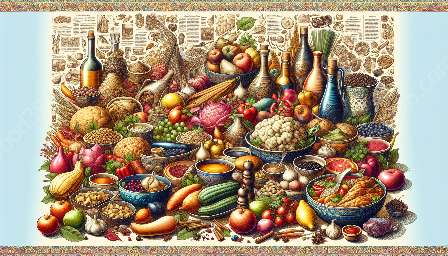The history of food storage and preparation materials in ancient times offers a fascinating glimpse into the origins and evolution of food culture, as well as the impact on ancient food traditions and rituals. From clay pots to grinding stones, these ancient tools and techniques played a vital role in shaping the way ancient civilizations stored and prepared their food.
Ancient Food Traditions and Rituals
Food held a central place in ancient traditions and rituals, with the choice of storage and preparation materials often reflecting the culture and beliefs of the time. For example, in ancient Egypt, grain storage was a crucial practice due to the importance of bread in their diet. The use of large granaries and storage pits demonstrated the significance of grain preservation. In ancient Greece, olive oil was a staple, leading to the development of pottery for storage and transportation. The use of specific vessels for wine and oil was also common in ancient Rome, indicating the importance of these commodities in their food culture.
Ancient food traditions and rituals were deeply intertwined with religious beliefs, community gatherings, and social customs. The choice of food storage and preparation materials was often influenced by traditions surrounding feasting, offering sacrifices, and honoring deities. For example, the use of ceremonial vessels and specialized cooking implements played a crucial role in religious ceremonies and communal feasts.
Origin and Evolution of Food Culture
The study of food storage and preparation materials in ancient times sheds light on the origin and evolution of food culture across different civilizations. The development of pottery and clay vessels, such as amphorae and storage jars, in ancient Mesopotamia, Greece, and Rome revolutionized food storage and transportation. These durable containers allowed for the preservation of food items and facilitated long-distance trade, contributing to the exchange of culinary traditions and the spread of food culture.
The use of grinding stones and milling tools in ancient civilizations laid the foundation for the evolution of food preparation techniques. The invention of sophisticated grinding and milling equipment enabled the processing of grains, spices, and other food ingredients, leading to the development of diverse culinary practices and regional cuisines.
Furthermore, the introduction of fermentation and preservation methods, such as pickling and drying, in ancient food preparation techniques significantly impacted the preservation of seasonal produce and the creation of unique flavors. These traditional preservation methods continue to influence modern food culture and culinary traditions.
Ancient Food Storage and Preparation Materials
Clay and Pottery
Clay and pottery were integral to ancient food storage and preparation. From storage jars to cooking vessels, the use of clay and pottery revolutionized the way ancient civilizations preserved and prepared their food. The ability of clay containers to maintain consistent temperatures and prevent spoilage made them essential for storing perishable items like grains, oils, and fermented foods.
Grinding Stones and Milling Tools
Grinding stones and milling tools played a crucial role in ancient food preparation, allowing for the transformation of raw ingredients into ingredients, flour, and meal. These tools were fundamental in the production of staple foods like bread, as well as the preparation of spices and condiments essential for flavoring dishes.
Fermentation and Preservation
Ancient food culture relied on fermentation and preservation techniques to extend the shelf life of perishable foods. Methods such as pickling, salting, and drying were employed to preserve fruits, vegetables, and meats, ensuring a stable food supply throughout the year. These traditional preservation methods became integral to the development of regional cuisines and culinary traditions.
Conclusion
The exploration of food storage and preparation materials in ancient times offers valuable insights into the interconnectedness of ancient food traditions and rituals, as well as the origin and evolution of food culture. The choice of materials and techniques used by ancient civilizations reflected their beliefs, customs, and environmental conditions, shaping the diverse culinary heritage that continues to inspire and influence modern gastronomy.


